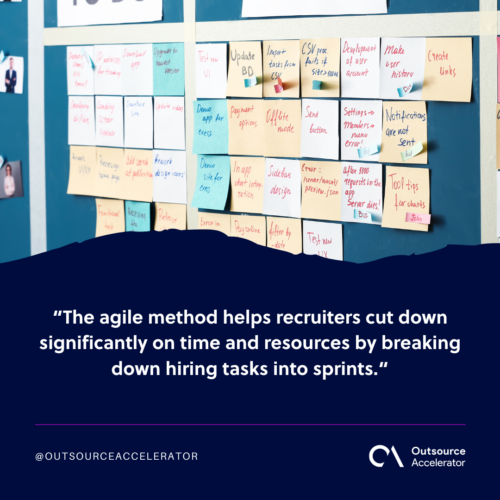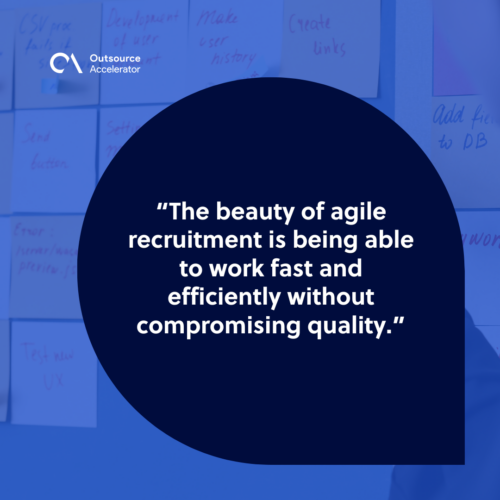Agile recruiting process explained

The job market has become increasingly competitive over the past few years, which requires companies to rethink how they attract and retain new candidates.
Businesses turn to agile recruiting to speed up the process. It helps them find the right talents in the shortest amount of time possible.
Continue reading to learn more about how this recruitment technique works.
What is agile recruiting?
Agile recruiting is a recruitment method based on the agile development model.
This model is used mostly by software development teams and relies on shorter time frames and faster and more streamlined operations. It allows teams to accomplish their tasks in small ways but in less time, reducing setbacks and increasing efficiency.
The same process could be applied when hiring new employees.
The agile method helps recruiters cut down significantly on time and resources by breaking down hiring tasks into sprints.
A sprint is a specific amount of time allotted for a specific task, which helps recruitment teams accomplish complex tasks quickly.

Benefits of agile recruiting
Several companies have adopted the agile recruitment process because of its numerous benefits.
Reduces time to hire
Every business knows how long it takes to find the right candidate, but the agile method helps reduce the time needed to hire and accomplish all recruitment-related tasks.
From the interviews to the actual deliberation process, businesses can make decisions quicker, narrow down the list of candidates to the best ones, and eliminate the unqualified ones.
Increased flexibility
The agile method allows recruiters to adjust their workflows better. They are not bound by a strict schedule that could cause bottlenecks or delays in the hiring process.
It is up to their discretion to manage their own time and complete tasks according to priority, which keeps things organized and efficient.
Real-time feedback
Traditional recruiting requires waiting until the end to determine whether a candidate is a good fit. Agile recruiting allows you to give and receive feedback on candidates the moment you see their resumes.
This saves you tons of time as you do not have to waste time on unqualified candidates and can redirect your attention to the qualified ones.
Improved productivity
The beauty of agile recruitment is being able to work fast and efficiently without compromising quality. Recruitment teams can receive feedback immediately, communicate better, and focus on one thing at a time.
Furthermore, all of this can be done on a recruitment software or platform where team members have access to candidate profiles and other tasks.

How to implement agile recruiting
Agile recruitment may seem simple on paper, but it requires a lot of planning and effort. Here are the basic steps on how to implement this setup:
Create a recruitment team
A good team is key to implementing the agile recruitment setup. Some recruiters use the Scrum framework, which involves working in sprints and is ideal for small recruitment teams.
A Scrum team usually consists of:
- Scrum master
- Project owner
- Recruitment team
Make sure each team member has a well-defined role that helps with the overall recruitment process.
Set goals and KPIs
It is important to have clear, concrete goals and KPIs to help guide your recruitment strategy. These are essential for measuring your team’s success and efficiency.
Some common KPIs include:
- Cost per hire
- Time to hire
- Candidates submitted to the hiring manager vs. Candidates shortlisted for an interview
- Candidates interviewed vs. Candidates who received an offer
Break down projects into sprints
This is the stage where you must create a structure for your hiring process. Determine which tasks can be completed within a specific time frame before proceeding to the next one.
Ideally, the agile method is a week-long process, meaning each goal must be completed within the week.
Let’s take a look at this rough example of what sprint recruiting looks like:
- Week 1: Candidate outreach and screening
- Week 2: Shortlisting candidates after feedback from the hiring manager
- Week 3: Interview stage (either via phone or video call)
- Week 4: Finalizing job offer
Be mindful of progress
As the weeks go by, remember to log your progress so the team has a clearer picture of where everyone stands. One convenient way to do this is by visualizing progress on a board or layout.
You can segment the board into different stages in the hiring journey and fill each stage with notes, names, or anything else that will help you better understand your current progress.
Evaluate metrics
Remember to monitor your metrics throughout the entire process. This will give you objective data on various areas, such as the number of successful candidates and hiring rates.
Doing so keeps your team informed of what is working and what is not. It allows you to make data-driven decisions for future reference.
Agile recruiting tips to remember
Agile recruiting can be easily implemented with the right mindset and practices. Here are some quick tips:
- Be remote-ready – Remote work is all the rage, so recruiters must ensure their agile method works well in remote settings.
- Stay flexible – You never know when you might have to rethink something during the process, so be open to adjustments.
- Communication is key – Maintain open communication with your team to ensure a seamless, transparent, and hassle-free agile process.
Perfecting the agile recruitment process
Agile recruitment is making recruitment a whole lot easier and faster for companies all over the world. It is not a difficult process, but things can still go wrong if you do not prepare well for it.
With the right amount of planning and communication, your recruitment process will be completely transformed for the better.







 Independent
Independent




